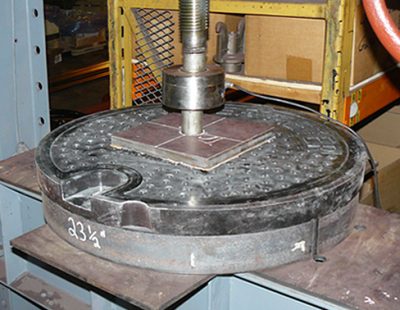For Construction Castings, such as Manholes & Meter Pit Lids, the Meaning for “H-20” is Frequently Misunderstood
The M-306 Standard
The American Association of State Highway and Transportation Officials (AASHTO) developed a standard, M-306, that calls for proof load testing of iron castings. For an H-20 proof load test, that standard requires a 40,000 lb. load be applied to a 9” x 9” square plate for one minute. Any cracks or permanent deformation greater than 1/8” are cause for rejection.
Polymer Lids
In recent years, polymer lids have been used for a variety of applications, such as:
- Water meter pits and manholes, where existing cast iron lids blocked radio signals.
- Flow monitoring devices in manholes, where signals of rising flow levels are likewise blocked by cast iron lids.
- Theft, due to the scrap value of iron.
- In industrial and sanitary manholes to reduce finger and back injuries, due to their light weight.

How the M-306 Standard Relates to Polymer Lids
Municipalities and engineers wanting a traffic rated polymer lid frequently specify an “H-20” rating in their specifications. There can be confusion since AASHTO published bridge design criteria, known as H-20, which calls for truck axle loading of 32,000 lbs, or 16,000 per wheel load. The AASHTO M-306 standard calls for a safety factor of 2.5 to be applied to the 16,000 lb. wheel load. (2.5 x 16,000 = 40,000 lbs). Therefore, for H-20 rated lids, a 40,000 lb proof load test is required. For H-25 rated lids, a 50,000 lb proof load test is required.
Explanation of the Confusion
Many water departments began to install radio read meters but couldn’t get a good read through cast iron lids. Frequently, many were only thinking of a radio friendly material such as polymer, without giving much thought to its strength. As a result, many municipalities received thin plastic lids that could only withstand a proof load test of 5,000 lbs or less. Frequently breakage occurred from lawn tractors and other loads. To be conservative and have an industry standard they can specify, many municipalities require a 40,000 lb proof load test, even where a lid is not in the roadway. Some suppliers advertise their lids as H-20, but are referring to a 16,000 lb wheel load and not a 40,000 lb proof load test. Some furnish lids that cannot even meet the 16,000 lb load they advertise as “H-20”.
How to Avoid the Confusion
To avoid confusion, your specs should specify the proof load test you require , conducted per AASHTO M-306. To be safe, require a report from an independent test lab. Simply specifying “H-20” may not provide the safety factor you need, particularly where traffic loads are involved. The AASHTO M-306 standard requires the load be placed at the center of the lid and not transfer any of the load directly to the frame. For smaller lids, such as 12” diameter, a plate smaller than 9” x 9” must be used. If you would like a proof load test performed on the lids you are using, contact Trumbull.
Trumbull offers a variety of polymer lids rated for a 40,000 lb. proof load. Reports from independent test labs are available upon request.
SLENDERNESS RATIO
This ratio is the unsupported length of the extension stem, divided by the “radius of gyration” of the stem cross section. The unsupported length is the distance between the extension stem Operating Nut and the Bottom Coupling, or when stem guides are used, the longest distance between any two “supports.” It is typically used to determine the susceptibility of a column to buckling.
What is “Lead Free?”
As of January 4, 2014, the Reduction of Lead in Drinking Water Act (RLDWA) changed the allowable lead free content definition in Section 1417 of the Safe Drinking Water Act (SDWA) to a weighted average of not more than 0.25 percent lead, with respect to the wetted surfaces of pipes, fittings, valves and other fixtures. These are Federal regulations.
Zinc Anode Caps
Zinc Anode Caps are threaded end caps, shaped like hex nuts, which are fastened to the ends of bolts or studs on a buried pipeline or related pipeline component. The zinc in an Anode Cap sacrificially corrodes before the steel of the fasteners, fittings or related components, which helps protect these items, thus extending their life and preventing possible damage from failed fasteners.





